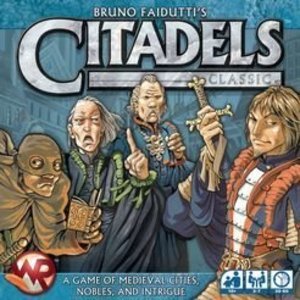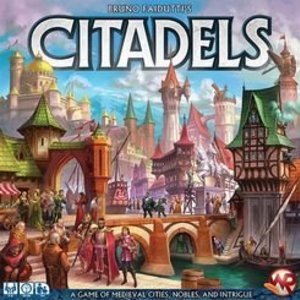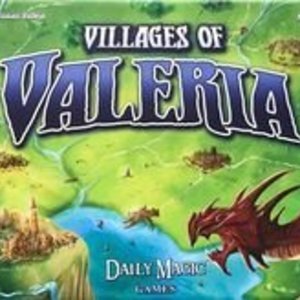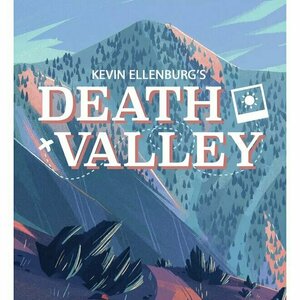
Death Valley
Tabletop Game
Sunlight glaring through the windshield. Your favorite songs blasting through the speakers. Candy...

The Pursuit of Happiness
Tabletop Game
The Pursuit of Happiness is a game in which you take a character from birth and you live the life...
The Game of Life
Purple Phoenix Games (2266 KP) rated Tiny Epic Western in Tabletop Games
Dec 30, 2021
Disclaimer: I do not intend to rehash the entire rulebook in this review, as there are just too many details, but will instead provide a more general overview of the rules and gameplay. -L
Tiny Epic Western is a game of worker placement and set collection in which players are trying to amass the most end-game victory points. Played over a series of rounds, players will be placing their Posse (Meeples), collecting Influence and taking actions, dueling opponents (if necessary), playing a bit of poker, and buying buildings in an effort to become the most powerful boss in this wild west town. To setup for a game, place the Location Mats as described in the rules, dealing a Building Card where appropriate. Each player receives a Boss card, 3 Posse tokens (Meeples), and one of each of the Influence trackers (Money, Law, and Force), placed on the 1 space of their card. Shuffle the decks of Building Cards and Poker Cards separately, choose a starting player (who receives the Dealer token), place the Wanted card/Gunslinger dice in the center of the play area, and the game is ready to begin! Pictured below is the starting setup for a 3-player game.
The game is played over 6 total rounds, each of which is broken into 4 phases: Shuffle and Deal, Posse Placement, Resolution, and Buy. To start a round, the Dealer shuffles the deck of Poker cards, and then deals 1 card face-up to the 6 empty spaces between the Location Mats. One Poker card is dealt face-down to the Rival Space (under the Town Hall Location Mat), and 2 Poker cards are dealt face-down to each player. Players look at both of their cards and pick 1 to keep, discarding the other. The round then moves to phase 2: Posse Placement. Starting with the Dealer, players will take turns placing Posse tokens onto the placement spots on any of the Location mats. All placement spots grant unique benefits (collecting different Influence or performing Building card actions) that are performed either immediately or during later phases of the round. What happens if an opponent took a placement spot that you wanted? Then it’s time for an old-fashioned duel! The dueling players each roll a Gunslinger die, modify it if they so choose, and determine a winner. Players continue taking turns placing Posse tokens until all available Posse tokens have been placed.
When all Posse tokens have been placed, the round moves to phase 3: Resolution. The first step of this phase is to reveal Poker cards – all players reveal their cards, and the card in the Rival Space is also revealed. Moving clockwise from the Town Hall, each Location will be resolved by ‘playing’ three-card poker. Each Location has 2 Poker cards directly adjacent to it (placed between the Locations in phase 1), and those 2 cards plus the one in your hand will form your Poker hand. Any players with Posse tokens on the Location will compare their Poker hands to determine a winner. If you win the hand, you collect the Winner’s Pot (extra benefits) and are able to collect any delayed benefits from placement spots in the Posse Placement phase. Losing the hand earns you nothing *womp womp*. If you are the only Posse on a Location (with no opponents) you will compare your hand to that of the Rival. The Rival’s hand uses the cards adjacent to the Town Hall, plus the revealed card in the Rival Space. If you have a better hand, you win the benefits on your Location. If the Rival wins, though, you do not collect these benefits. All Locations are resolved in this fashion before the last phase of the round, Buy, begins.
To start this phase, all players will compare their three-card Poker hands using the 2 Poker cards adjacent to the Town Hall. The player with the best hand will act first in this phase, followed by the next best hand, and so on. The first player may now choose to buy a Building card from any Location on which they have a Posse token. Pay the requisite amount of Influence to purchase a Building, and add it to the Porch Slot on your color-corresponding Location Mat. The power granted by this Building card is now available for use in future rounds. Once all players have had the option to purchase a Building, the player with the best hand will advance one of the Industry Tokens at Town Hall. The placements of Industry Tokens will affect end-game scoring, so keep that in mind as the game progresses. When all steps of the Buy phase are performed, the round now ends. Players collect all their Posse tokens back to their boss cards, all Poker cards are collected and re-shuffled, new Building cards are dealt to Locations from which they were purchased this round, and the Dealer token is passed to the next clockwise player. If a player did not buy a Building at all during the round, they have gained the Third Posse Benefit for the coming round – granting them an additional Posse token to place during phase 2. Otherwise, all players will only ever have 2 Posse tokens to place.
After a total of 6 complete rounds, the game ends and points are tallied. Victory Points are earned from Building cards bought throughout the game. Building cards have a specified VP amount, and also have a collection of Industry Icons on them. Using the final placement of the Industry Tokens on the board, players will earn points for Industry Icon sets they have collected. And finally, whomever holds the Wanted card (won the last duel) gains an additional 2 VP. Points are all counted, and the player with the highest score is the winner.
That all probably sounds pretty complicated. But I do have to say that verbally explaining/teaching the game (and being able to use components for examples) is waaaaay easier than doing so through a text review. So please do not let the seemingly complex gameplay turn you off from this game. Once you get a basic understanding of the phases of each round, the game moves along pretty seamlessly. Honestly, the biggest learning curve for me to conquer was playing three-card poker. As someone who has never played any form of poker before, this was probably what had me most hesitant about learning TEW. After having played it now, three-card poker really isn’t too complicated, and there are some nice player reference cards to help you figure it out.
Aside from the poker element, this game really comes down to worker placement and strategy. Each Location card only has a finite number of placement spots, and the resources required to buy Buildings are not exactly in abundance. This affects your strategy, as you must decide which resources to collect at what times, as well as deciding whether you need to duel someone for a coveted resource. Another element to your strategy? You may only buy Building cards from Locations on which you have a Posse token. Maybe none of those placement spots really appeal to you this round, but you reaaaaally want that specific Building card. Are you willing to ‘burn’ a Posse token for the chance to buy it? Or is there a different Location that offers a useful resources and a desirable Building card? Also, keep in mind how your poker hand will come into play. Since poker cards are dealt to each Location at the start of a round, you are able to see what your hand will be for each Location. Maybe you have a pretty strong hand at the Bank Location, but at the Courthouse the cards end up being a bust. Are you willing to risk a placement in hopes that you have the best hand of the bunch? Because remember – if you don’t have the best hand at a Location, you get no resources/rewards! There are so many elements to a successful strategy with this game, and it really keeps all players engaged at all times. Be warned though – the variety of strategic options could be difficult for some AP-prone players.
Let me touch on components for a minute. As with all Tiny Epic games, the production quality of TEW is pretty stellar. The cards are nice and sturdy, and the iconography is clear. The Posse tokens are cute Meeples with cowboy hats, and they are nice and chunky. The only thing I don’t really like about this game are the Gunslinger dice. In theory, they are super cool, but in actual execution, they leave much to be desired. The numbers aren’t really clearly define, so they’re a bit tricky to read. Aside from that, a pretty high quality game here.
So all in all, how does Tiny Epic Western stand up in the series? It is definitely one of the heavier games of the bunch, and there is so much more going on than initially meets the eye. It feels daunting for the first few plays, but once you get the phases under your belt, it really flows pretty well. I can’t say that it is my favorite Tiny Epic game, as I just personally feel like there are too many elements going on at the same time. You’re strategizing your worker placement, but also need to consider buying Buildings for VP and to collect sets of Industry Icons and for their specific abilities, as well as figuring out your poker hand for 5 different Locations, and dealing with duels. Some people might really be into that amount of strategic forethought, but it feels a bit cumbersome to me. That being said, Purple Phoenix Games gives this three-card poker game a 3/6. The gameplay is decent, just not really my kind of game.
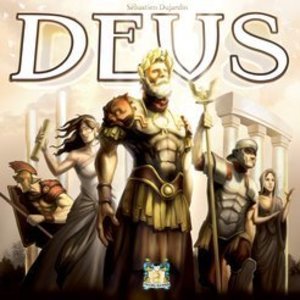
Deus
Tabletop Game
In Deus, players work to develop their own civilizations in a shared environment. Each player starts...
Boardgames CivGames

Draft Simulator for FUT 18
Sports and Entertainment
App
Download the best FUT 18 Draft Simulator to enjoy the fun of building drafts with latest FUT 18...
Purple Phoenix Games (2266 KP) rated Villages of Valeria in Tabletop Games
Jun 12, 2019
In VoV you are a Duke/Duchess being charged by the King to found a new Capital City to replace the previous one that has been ravaged by the wars played out in VCK. The King has assigned you a castle to use as your HQ and expects the most enterprising Duke/Duchess to win the day by building the most flourishing village. Will you be able to create the resources necessary to build the most attractive buildings that adventurers will want to frequent? Or will you spend your time taxing your constituents to death?
DISCLAIMER: This review focuses on vanilla Villages of Valeria. We have all the released expansions and may do a review of them in the future. If we do, we will edit this review or link to the new review here. -T
VoV uses a handful of really great game mechanics that will be familiar to some gamers, but not intimidating enough to scare off new gamers, that really work well together to create an excellent gaming experience. I will address most of them here, but please do not use this review as a replacement for the rulebook, as I will not be addressing every single rule.
VoV is played over several rounds where every player will be taking a turn as the active player until someone has built the requisite number of buildings prescribed in the rulebook to trigger the end of the game. Each player starts with a castle card that provides a wild resource of your choice when you need to pay resources to build buildings on future turns. You are also given gold and a starting hand of cards in accordance with setup rules. Setup the decks of cards and create the offer rows for each and you are ready to play!
When you are the active player you will take an action from a list of five available actions: Harvest, Develop, Build, Recruit, and Tax. If you choose to Harvest on your turn you will draw three cards from either the face-up green building cards on the offer or blindly from the deck of green building cards. To Develop you will play a building card from your hand to the back of your castle, tucked underneath and upside down, to be used as the resources printed at the bottom of the card (wood, magic, stone, food). These resources are now available to be used for the build action (think of the brown and gray cards in 7 Wonders, if you’re familiar). When you take the Build action, you will be playing a building card from your hand to be built in the tableau in front of you. Since number of buildings is the end game trigger condition, you will be trying to build buildings as much as possible. All building cards have a cost printed on the left side of the card, and those costs will need to be paid for by using the gold you possess. You can use one gold on your own castle card as it provides a wild resource to you, and you can use one gold per card you have Developed previously for their resource benefit. You may even spend your gold to use an opponent’s resources (not their castle! – also akin to 7 Wonders neighbor resource purchasing). The catch here is that you lose that gold piece to your opponent, but they will not be able to use that resource until the beginning of their turn as active player. Most buildings will have benefits printed on them that either take effect immediately or when triggered by another action. When you Recruit an Adventurer, you are using your village’s buildings to attract them to your cause. Each Adventurer’s cost to recruit is printed on the side of the card, and these costs are paid by having the matching symbols on building cards in your village. Once recruited, these Adventurers can also enact conditional abilities similar to building cards, but usually will be advantages to final VP scores. By taking the Tax action you will take one gold from the bank and draw a building card from the offer or the deck.
Now this all seems pretty easy and I have only really mentioned one form of tension by blocking opponents’ use of their own resources if you spend a gold to use it on your turn. Since you reclaim all gold on your castle and resource cards in your village at the beginning of your turn this should cause no problems, right? Well, VoV also uses the follow mechanic that has been employed by other games previously. When you are the active player you choose which action you want to take on your turn, complete that action, and then the same action is offered to your opponents for them to take at a disadvantage. Example: I choose Tax as my action, so I take my gold and my card and my turn is over. Then, going around the table, each player can decide to follow my action but are only able to take a building card as a follow action. No gold. Each action has a Lead and Follow benefit, so you are always paying attention during the game, even on others’ turns because you might still benefit from the chosen actions.
Play continues like this with active player Lead actions and possible others’ Follow actions until someone triggers the end game condition. Then everyone completes the turn and VPs from all cards in your tableau are added (including gold pieces you collected). Most VPs wins the game of Villages of Valeria!
Components. Okay, I have to admit that I have the Kickstarter Deluxe version of this game so I am only speaking from experience with that version. The cards are of really good quality. The gold tokens and active player castle token are great, but the action tracker we found a bit cumbersome to use so we just, like, didn’t. The building tracker and castleeples are great as well. The art is by The Mico, and I just love his art style, so that’s a big positive for me. Overall, the components are really really nice.
So why do I love this game? Well, it’s really a mashup of mechanics that work well for me. I love the Lead/Follow mechanic. I love 7 Wonders, so borrowing some of those mechanics and nuances is a great fit for me. I absolutely LOVE The Mico’s artwork on every Valeria game. No two games of VoV will be alike because the amount of cards that come inside the box (and growing with every expansion) gives such a diverse gaming experience that I love playing. If you like any of the Valeria games and you have yet to try Villages of Valeria you MUST find a copy. You will be drawn in by the familiar feel of Valeria and mechanics from classic games that will surely delight. We at Purple Phoenix Games give this gem a bustling 20 / 24. Long live Valeria!
https://purplephoenixgames.wordpress.com/2019/04/05/villages-of-valeria-review/
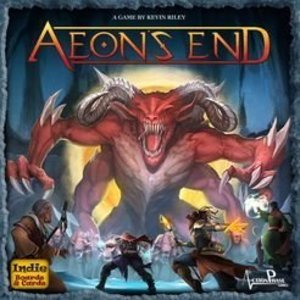
Aeon's End
Tabletop Game
The survivors of a long-ago invasion have taken refuge in the forgotten underground city of...

